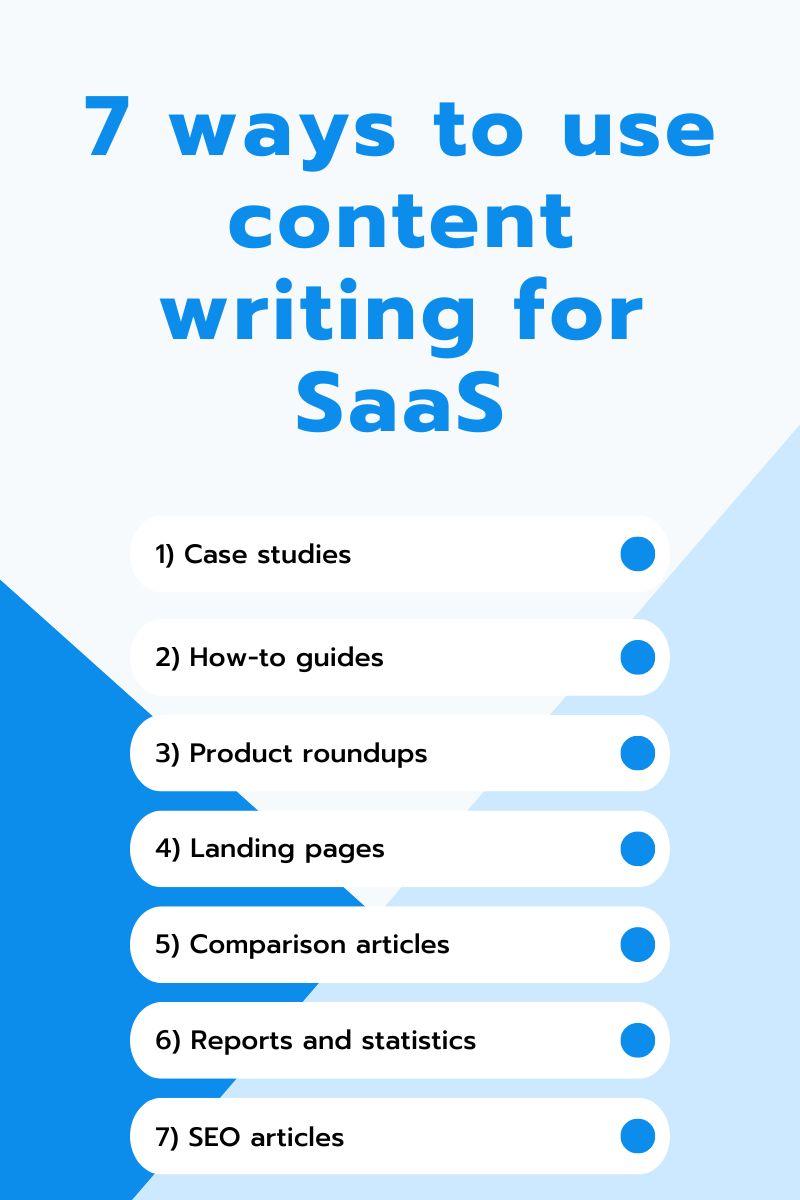Do you have a great idea for a SaaS business? Projected to grow from $273.55 billion in 2023 to $908.21 billion by 2030, the SaaS industry is looking better by the minute.
But even if you have an amazing product, you need a way to present it in front of your target audience. Content writing for SaaS can be your key to building a strong online presence and creating content that attracts potential clients and drives conversions.
In this article, I want to explain what content writing for SaaS is and help you understand how you can use content to position yourself strongly among the growing competition.

What is content writing for SaaS?
Content writing is a type of inbound marketing strategy. The goal of a content writer is to represent your business across different mediums and help your target audience find it. Once they find you and are aware of your business, content writing for SaaS leads people through a buyer’s journey to help them make a decision, aka purchase from you.
Even after you land a client, the job of a content writer doesn’t end there. You have to use content writing to answer your clients’ questions and help them solve problems.
So how is content writing for SaaS different from, let’s say, writing about consumer goods?
It follows the same process but focuses on SaaS-specific content. SaaS as a product is different from physical goods you buy once and carry on. SaaS isn’t as tangible. It’s a digital service designed for long-term use. Professional SaaS content writing has to address that and use strategies that work for this type of business and its customers.
The benefits of content writing

Boosting organic traffic
Content is the main ingredient that drives organic traffic to your website. It’s the way search engines like Google identify what your website is about and what it provides for visitors.
However, just because you put random text, it doesn’t mean it will help you rank. Search engines are getting smarter by the day. While years ago, you could have ranked at the top of Google by stuffing your content with keywords, now the criteria have changed.
Google asks for quality and helpful content. It means that when a person searches for a particular term or phrase, it’s Google’s job to suggest websites where they can find the right information.
Currently, the key standard for website content from Google is EEAT, which stands for:
- Experience – your unique experience with the subject. Think about client case studies, something you’ve discovered that works in your business, and other relevant experience pieces you can share.
- Expertise – what expertise do you have to talk about your subject? If you provide health advice, are you a trained physician? Giving legal advice – are you a lawyer?
- Authoritativeness – are you an authoritative figure in your industry? That means being published in other reputable publications, having a strong social media presence, previous work experience, and similar proof that you’re an authoritative source of information in the industry.
- Trustworthiness – can a visitor trust you and your website? Is your content original and linked to original information sources? Can a visitor easily contact you or find your privacy policy? All these things matter when generating traffic to your website.
A content writer can help you find your place in the market through content. A professional will use the EEAT strategy when creating content to bring your business to the top of searches for your relevant key phrases.
Positioning yourself in the market
You need content to establish your business in the industry. And I’m not only talking about website content. You also need a social media presence, a knowledge base for your existing customers, customer cases for social proof, and other ways to get your business closer to its target audience.
Establishing credibility
Credibility is another very important aspect of being among the top businesses. That’s why new websites and blogs struggle to rank initially. A content writer can help you build credibility by writing original and valuable content.
Back it up with statistics, your own research or experience, and interview other industry leaders to build your credibility through content.
Educating clients
Content plays a crucial role in educating your customers. One of the best ways to attract new customers and show the existing ones you care about them is to produce useful and actionable content.
For example, one of my B2B clients provides SMS marketing services for other businesses. Most of the content they create is about SMS marketing and how to use it in business, what the benefits are, and other educational content. This way, their blog posts aren’t too salesy and actually serve as a credible resource of information.
Educating customers also goes beyond that. As your business grows, your sales and customer support teams might get overwhelmed. Having content pieces answering common questions can make their lives easier because your clients can solve problems on their own.
Driving more conversions
The quality content strategy works like a wheel. It attracts traffic to your website, spins the visitors through the buyer’s journey, and keeps them engaged to commit to your SaaS solution.
For example, let’s say you offer a client booking system for beauty salons. You’ve already invested in content writing and have a lot of top-of-the-funnel content to generate traffic but with little sales value.
You have your ideal customer – a salon manager who wants to manage all their bookings and reminders through a system. But after reading some top-funnel articles, they don’t take the next step because it doesn’t lead them anywhere. What happens? You lose a potential customer.
Professional content writing guides the visitor from the top of the funnel to your product, where they can become a customer. Instead of just scratching the surface, the writer strategically introduces your software solution, presents clients with its features and benefits, and leads them to consider you as a service provider.
This includes your website content, emails, social media posts, and other information you put out there.
7 ways you can use content writing for SaaS

Now you know why SaaS businesses must invest in quality content. But what does that content actually look like in practice? Here are 7 ways you can use content writing in your SaaS business.
1. Case studies
Client case studies are like testimonials on steroids. SaaS solutions are usually quite complex. But one of the best ways to demystify your service is to show how it works in real life.
Client case studies follow a simple structure of introducing one of your clients and the problem they had before they tried your SaaS solution. It describes how they used your solution, the problems they solved, and the features they used. It gives social proof for your future customers and demonstrates how similar businesses have used and benefited from this solution.
2. How-to guides
A how-to guide is a long-form blog post that describes how your product works or how to solve common problems your clients have.
For example, if you provide a team management SaaS solution, some of the how-to guide examples could be:
- How to manage a large team with (X) solution
- How to save time scheduling employees
- How to track employee time
These types of articles hang at the top of the funnel and are usually the first interaction your potential customer has with your business. They shouldn’t be too salesy and might not even mention your product. But they solve problems and encourage visitors to read and discover more.
3. Product roundups
Product roundups are articles that showcase a curated selection of software solutions within a specific niche or category. You might have seen similar blog posts like “10 Best Email Marketing Software Solutions” or “20 Businesses in Europe Revolutionizing Healthcare”.
Usually, such articles introduce relevant SaaS products based on the target audience’s needs and preferences. Each product roundup includes a brief description of a product, an evaluation of features, functionalities, pricing models, and customer reviews.
The goal is to compare the strengths and weaknesses of each SaaS solution and provide recommendations to help readers make informed decisions. But also, product roundups let you showcase your product among your competitors, allowing interested readers to see how you stand out.
4. Powerful landing pages
A landing page is a stand-alone page dedicated to your product or a specific feature the product has. It’s called landing because typically a visitor lands on this page by clicking through an ad, social media, email link, etc.
There are many different types of landing pages, but most of them have shared goals of generating interest, instilling confidence in the product, and encouraging users to take the desired action. Usually, the action is to sign up for a free trial, request a demo, subscribe to an email list, or make a purchase.
5. Comparison articles

Similar to product roundups, comparison articles also directly describe products. But instead of talking about 10 or 20 different solutions, you focus on your SaaS product and one of your competitors.
Comparison blog posts go more in-depth into the features, solutions, pricing, and other details of the two products.
Writers analyze each software’s strengths, weaknesses, and unique selling points. The content typically follows a structured format, presenting a side-by-side comparison of the features and benefits of each software.
The goal of comparison blog posts is to help readers evaluate their options and select the best service provider.
However, comparison articles allow you to showcase your advantages over your competitors. This way you can target your biggest competitors because they’re known in the industry and might generate more interest from your target audience. But that is also why readers might be interested in alternative solutions. Or they might be looking for some features your competitor doesn’t have, but you do.
6. Reports and statistics
Unique reports and statistics can be one of the highest ROI content pieces you publish on your website.
Simply put, creating reports and statistics for SaaS businesses involves collecting and analyzing relevant data, trends, and insights within the industry or niche your software serves.
Your content writer might collaborate with data analysts and subject matter experts to identify key metrics, conduct surveys, and gather qualitative and quantitative information.
Then, they put this raw data into reports and statistics that highlight industry trends, market opportunities, and emerging challenges.
You have multiple ways to use these reports. You can publish them on large media outlets, like these examples:
Such content provides authoritative information that can be leveraged for press releases, media pitches, guest articles, and social media campaigns. By showcasing your business’s expertise and thought leadership through data, content writers help position your company as a trusted authority in its field, attract media attention, and drive brand visibility and credibility.
Statistics and reports also work wonders when building backlinks because many other publications will link to your source when citing your studies and findings.
7. SEO articles
Content writing for SEO articles involves keyword research, strategic content planning, and quality writing tailored to search engine algorithms and your target audience. SEO articles are optimized with keywords, headers, meta tags, and internal/external links to improve search engine visibility and ranking.
For SEO articles to work and drive traffic, you must have an on-page SEO strategy. That involves planning your content pages based on keywords and search intent.
I always recommend my clients to build content clusters where they cover each product or feature they offer with several blog posts. This way, you can target different keywords and position yourself as a go-to source on the subject.
Professional content writing services for your SaaS business
I hope this article gives more information on why content writing is important for your SaaS business. There are so many ways you can use content to promote your services and be at the top of your competitors. You only need the right strategy and person to help you achieve that.
If you’re looking for a SaaS writer, no need to look any further. Hello! My name is Egle, and I’m a professional freelance SaaS copy and content writer. I’m here to help your business build authority, credibility, and generate more traffic to your website.
I offer to kick-start your content marketing with the right strategy or keep up the good work with retainer services. Check out some of my work and let’s talk content!


